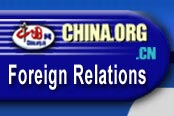Increased scaffolds in the downtown area, long queues at the customs, and billboards with both Chinese and Russian advertisements are hallmarks of bustling trade along the Heilongjiang, the boundary river between China and Russia.
Officials of Heihe City, the first frontier trade pass which reopened Sino-Russian border trade in 1987 with a melon-for-carbamide deal, have been busy preparing for trade talks between Chinese and Russian businesses. They could hardly spare the time to meet non-business people.
Decoration of the trade building is going on in the city, construction of which was suspended a few years ago due to the sluggish border trade.
Using simple Russian words they just learned, traders from east China's Shanghai Municipality and Zhejiang Province bargain with business people who have come across the river.
In front of them, numerous "Made-in-China" commodities, from instant noodles to game machines, are piled high on the small island in the middle of the river.
The scene most frequently seen by outsiders in the Chinese border city are tour guides showing around their guests with small yellow flags held above their heads.
"We are much busier than before," said Fu Kejia, a 25-year-old tour guide, "the number of people who wait to pay for a cross-border visit has increased on both sides."
Everyday goods worth 1 million yuan (about 120,000 U.S. dollars) are transported across the border in Heihe. Eight Chinese and Russian passenger-cargo vessels, including the novel catamaran, shuttle back and forth in the Heilongjiang River.
China and Russia, which share a 4,000-kilometer border, are negotiating to build the first bridge across the river to enhance bilateral trade.
Sino-Russian border trade, with a history of more than 100 years, reached its climax in the early 1990s, shrinking all at once in 1994 when many of the several thousand trade companies withdrew from the area, blaming random marketing for the downfall.
The situation this year, however, has been improving as trade along the Sino-Russian border markedly increased. Heilongjiang Province's foreign trade with Russia grew by 78 percent during the January-July period.
The light industry products Russians wants and raw materials Chinese demand flow out and pour in incessantly. The bustling scene was taken as a sign of the powerful recovery made in Sino-Russian trade since last year, although it has yet to accomplish the goal set by the top leaders of the two countries.
The mutual complement between China and Russia has been visualized by the latest economic revival in Russia, the fast growing economy in China, and the common strategic interests that attract importance from both countries, according to analysts.
Chinese border cities have established direct financial settlement relations with banks across the river to avoid possible business risks which appeared in the early period, said Yu Xiaodong, secretary of the Heihe City Committee of the Communist Party of China.
The two sides also endeavor to cultivate some large trade companies with good credit and financial resources, he said.
The efforts made by China and Russia towards their accession to the World Trade Organization are conducive to the maturity and stabilization of bilateral trade relations, experts said.
"We are getting out of difficulties," said Yu. "The recovery of the border trade is a symbolic of closer Sino-Russian economic ties."
(People’s Daily 09/07/2000)
